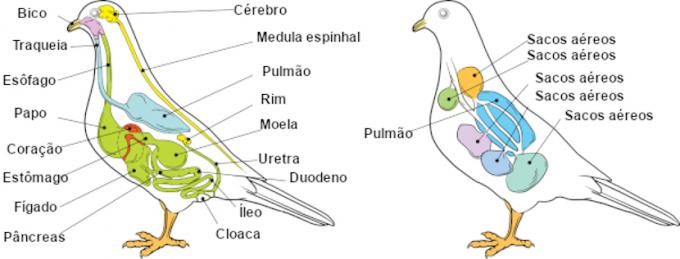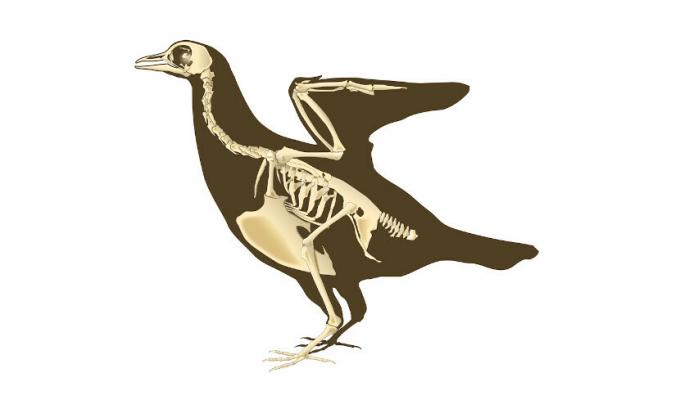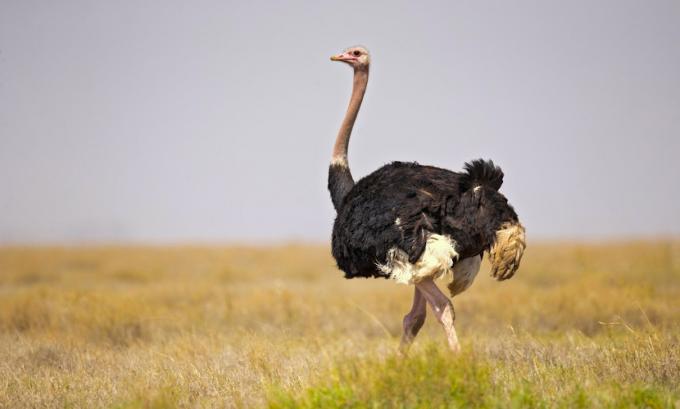At birds are vertebrate animals that stand out for the presence of their feathers, a unique feature of that group. Many species have the flight capacity, butnot all fly, having swimming and running species. Currently, it is estimated that there are about 10,000 different species of birds around the world. cite as examples the eagle, the hawk, the pigeon, the hen, the rhea, the duck, the penguin, the ostrich, among others.
Read too: Why aren't all birds birds?
General characteristics of birds
Birds are vertebrate animals whose most striking feature is the presence of feathers, which are made from keratin, the same protein found in reptile scales. Another striking feature is the fact that these animals are endothermics, that is, keepêm your body's constant temperature thanks to your metabolism. With this, these animals can live in different environments, as they do not need external heat to keep warm. We find birds in almost all places of the planet, being possible to observe them, for example, in desert regions, in the poles, in forests and oceanic islands.

Birds feed on different products, existing species that present carnivorous, herbivorous and omnivorous diet. The digestive system of birds is complex, with structures such as beak, crop, proventriculus and gizzard.
O nozzle helps the bird to capture and manipulate its food, being possible to observe different types of beak, which are adapted to the type of food ingested for the bird.
O chat it is a dilated region in the esophagus that serves as a kind of storage chamber. In this place, the food is stored and also softened and moistened.
O proventriculus acts as a chemical stomach, being responsible for the secretion of gastric juices.
THE gizzard, in turn, acts ensuring the crushing of food, working as a mechanical stomach. Inside the gizzard, grains of sand and small pebbles can be found, which help the birds in this crushing process. It is noteworthy that these animals have cloaca, a common output from the digestive, urinary and reproductive systems.

Concerning excretion, birds have kidneys as specialized organs in this process. Thus like reptiles, they excrete uric acid. An interesting feature of the group is the lack of urinary bladder, which also helps these animals in flight, by making them lighter.
The birds present circulatory systemO closed, with blood flowing into blood vessels. The heart is divided into four cavities, two atria and two ventricles, just like in mammals. THE breathing of birds is pulmonary, presenting air sacs connected to the lung, which act by amplifying the air flow.
they have well-developed vision and colorful. Hearing is also a well-developed sense in these animals. The olfactory and gustatory senses are little advanced in most birds. It is also worth saying that the visual and motor area in the brain is well developed, as well as the cerebellum, being larger than that presented in amphibians and reptiles.

The vocal tract of birds is called syrinx and is located in the trachea. In some species, Is it over there no it is present, as in vultures. All birds, however, have the ability to produce some kind of sound, but the structures vocals vary from one species to another, and it is possible to observe the emission of different types of sounds.
Read too:Why do birds sing?
Adaptation of birds to flight
Birds have a series of characteristics that guarantee The some species the facilitation of flight.

Among the main adaptations of birds to flight, we can highlight:
Ppresence of feathers, which help in flight and also in thermal regulation.The;
Thesas, which ensure an aerodynamic shape to the animal;
mdeveloped pectoral muscles, which ensure the movement of the wings;
andsternum with a keel, where the pectoral muscles are attached;
Opneumatic bones, that is, bones that have air-filled cavities, thus helping to reduce the weight of the grandmother.and;
Theurinary bladder and teeth, as well as reduced gonads, which aids in flight by decreasing the animal's weight.
Read too: Kiwi, a bird from New Zealand
Do all birds fly?
It is important to make it clear that not every bird has the ability to fly. In general, we can say that these animals have three basic means of locomotion: flight, bipedal gait using the hind limbs and boosted swimming. As birds that perform the bipedal gait, we can mention the ostrich and rheas. As an example of swimming birds, we can mention penguins.

bird breeding
All birds are dioic, therefore existing males and females. Fertilization is internal, with the transfer of sperm to the female through contact between the opening of the cloaca of these animals. Birds are exclusively oviparous, that is, they lay eggs where the embryo develops.
Birds are animals that show complex behavior when it comes to reproduction. different courtship rituals. In some species, for example, several males get together and perform synchronized displays for the females so that they can choose their partner.
After the couple is formed, the birds usually build a nest, which is the place where the eggs incubate. For the embryo to develop, it is important that the egg receives body heat from the parents. The incubation period is different for different bird species. After birth, the parent carethere and, nomost species, males and females workm to feed the chicks.

